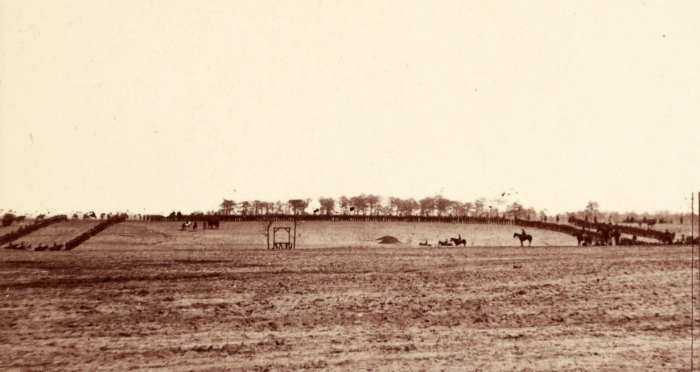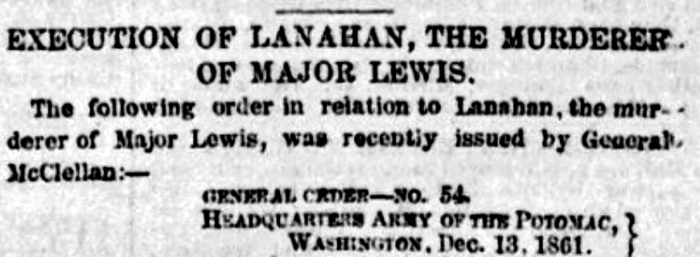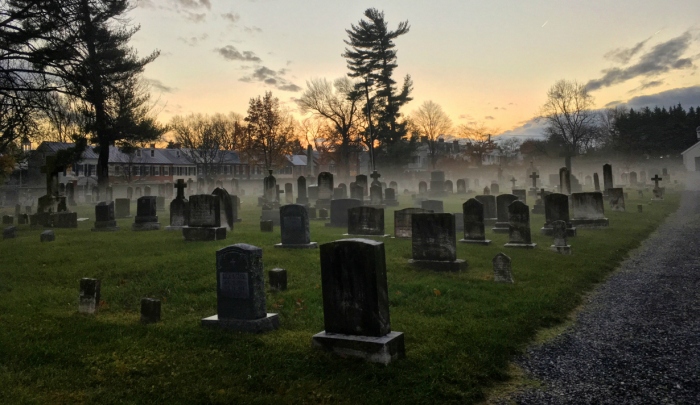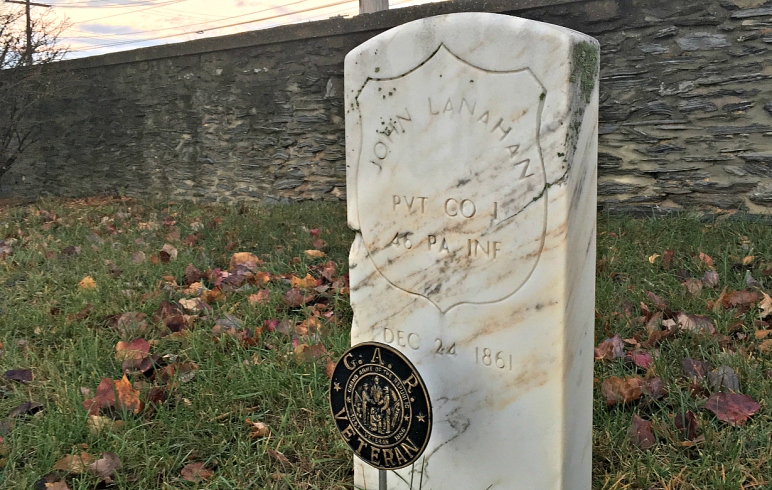The white, government-issued stone at St. John’s Catholic Cemetery in Frederick, Maryland stands alone, separate from a row of similar markers only a few feet away.
It reads simply:
John Lanahan
PVT CO I
46 PA INF
December 24, 1861
A misprint – John Lanahan died on December 23, 1861.
Let’s go back to that day.
A strong wind ravaged the thousands standing in hushed silence on a hillside overlooking the clustered church steeples of Frederick. Sleet blew against their faces as they stared across a hollow square at the scene. A hastily constructed scaffold lay at center stage, the lifeless shape of Private John Lanahan loomed over them all.
“The body, swaying in the wind, was completely covered by snow as the regiments filed past,” wrote one observer of the scene.

The scene was the culmination of a three month-long drama in military discipline. Thirty-year-old Private Lanahan of the 46th Pennsylvania had undergone numerous court martial proceedings and they were unanimous. Private Lanahan must die for his crimes.
Lanahan enlisted in Company I, 46th Pennsylvania Volunteer Infantry regiment on August 23, 1861 in Scranton, Pennsylvania. The regiment left Harrisburg, Pennsylvania in September and headed toward the front. They joined Nathaniel P. Bank’s division of the Union Army in the borderlands along the Potomac River in Maryland.
On September 22, while the regiment was on duty at Muddy Branch, in Montgomery County, Private Lanahan was arrested for fighting with another Irishman in his company while intoxicated. Major Arnold Lewis ordered Lanahan tied to the rear of a baggage wagon as punishment.
At some point, while the regiment began to march, Lanahan had broken loose of his chains, armed himself with a musket, and actively hunted for his jailer. “The Major, accompanied by Assistant Surgeon W. Charles Rogers, rode towards Lanahan and ordered him to give up the gun,” recorded a reporter on the scene.
“Lanahan refused; and while the Major was in the act of getting off his horse to enforce the order, Lanahan retreated a few steps, took deliberate aim, and shot the Major in the back with a ball and three buckshot.”
The beloved Major Lewis died within minutes.
Lanahan was immediately placed under armed guard and his journey through the Union Army’s military justice machinery began. On October 21, 1861, a court martial was convened at headquarters near the front. The officers found Private John Lanahan guilty of the charge of murder and “therefore did sentence him… to be hanged by the neck till he be dead.”
The findings of the officers at Frederick were confirmed by Major General George B. McClellan on December 13 and the date for the sentence to be carried out was set for December 23, 1861 at Frederick, Maryland where Banks’ division had begun to settle in for winter quarters.

The 23rd dawned storming and windy in Camp White, the temporary quarters of the 28th New York Volunteers three miles west of Frederick. The encampment “was in a beautifully situated maple grove at the foot of the mountains, on an elevation overlooking the city,” wrote one member of the 28th New York.
By noon, a worsening storm of sleet and snow had blown in from the west. Proceedings were scheduled for 2 o’clock in the afternoon. Thousands of soldiers encamped near Frederick were marched west toward the mountains to the scene of the execution.
Among the men standing, awaiting the Lanahan’s arrival from the guard house in Frederick was Private Van Willard of the 3rd Wisconsin. Willard left his post as a nurse at the regimental hospital, located inside a pair of Revolutionary War-era stone buildings nicknamed the “Hessian Barracks,” as “the wind blew fiercely, dashing the sleet against the wooden panes and whistling around these old barrack buildings like the wail of a thousand fiends.”
Private Willard leaves behind the most moving narrative of the events. Below is his account of the affair, written in his journal on December 23 and Christmas Eve, 1861.
I was present at the execution, never did I witness a more revolting spectacle… It was a sad affair to see him hung – he was so young, so interesting in appearance. There was not a soldier’s heart that did not throb with emotions of sympathy. As the carriage in which he was approached the place of execution accompanied by the Wisconsin 3rd, the band played a solemn death march and the long line marched slowly on, forming a hollow square around the scaffold.
The prisoner viewed the preparations for his death calmly and without a shudder. He was very cool and self possessed and walked up the scaffold with a firm tread, and looked calmly around the long lines of soldiers below
He was very pale but bore his fate without a murmur. When upon the scaffold, he was asked if he was ready. He said he that he was, that he was ready and willing to die,and that he had nothing to say only[,] “tell the soldiers to shun the use of intoxicating liquor.” All then descended from the scaffold and he was kept standing alone. The trap was sprung – he fell, his neck was broken, and after a few slight struggles he was dead.
Private John Lanahan’s body was taken to St. John’s Catholic Cemetery in the northeastern corner of Frederick and interred without pomp nor circumstance.

He remains their today, under a stone that misstates the day he died.
